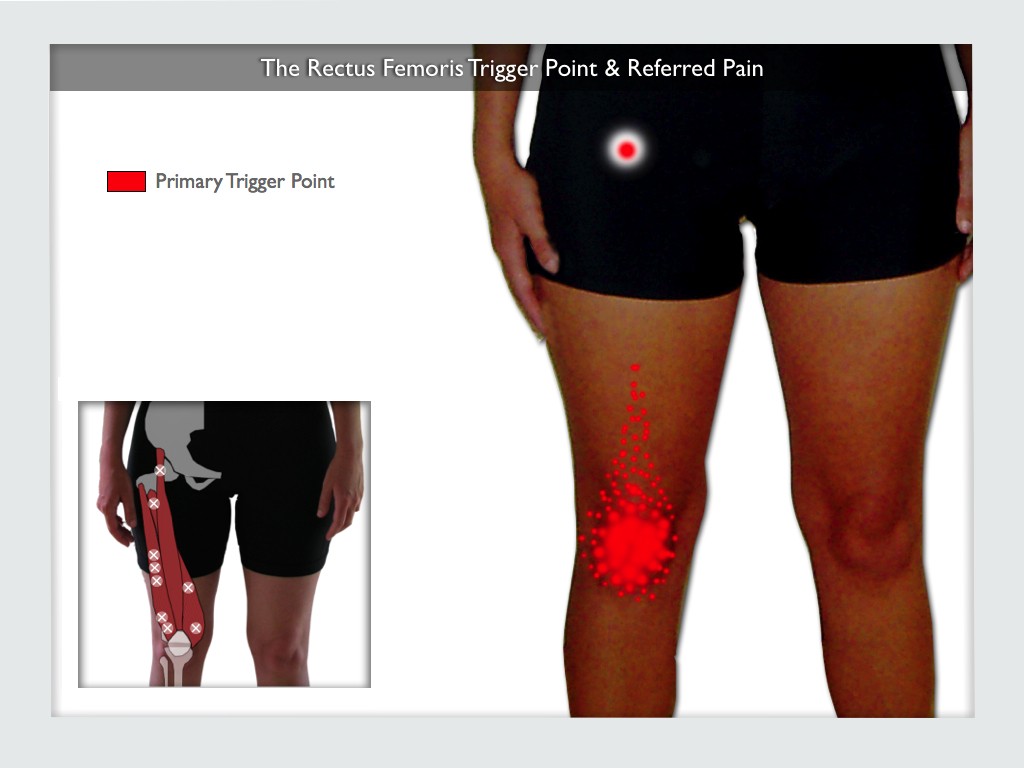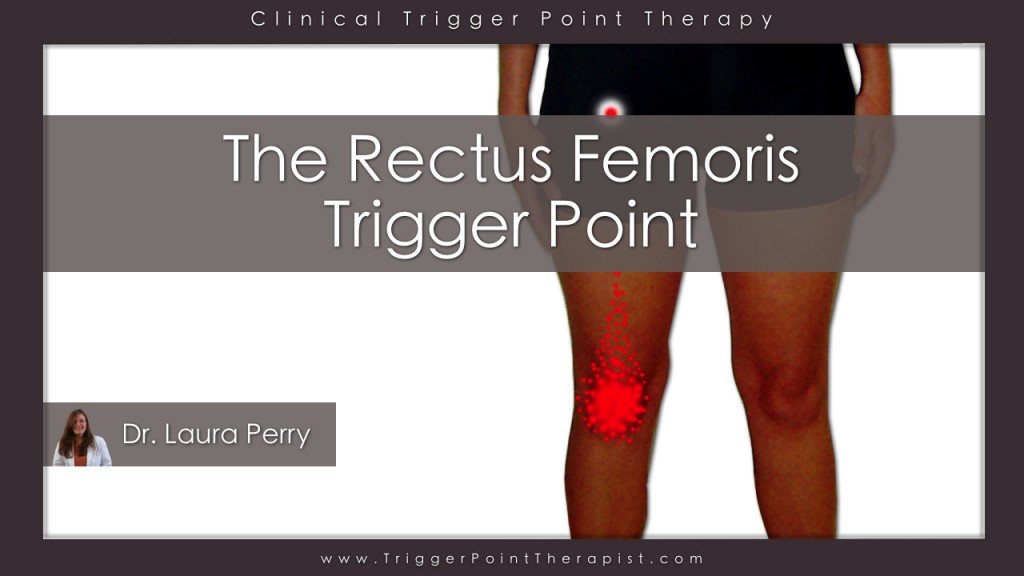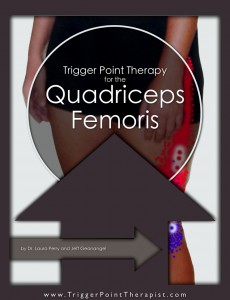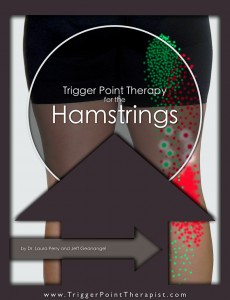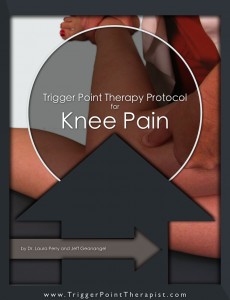Trigger points in three of the four quadricep muscles can cause knee pain disorders. The rectus femoris muscle and its trigger point will be discussed in this article, which is part two of a three part series on the knee pain trigger points.
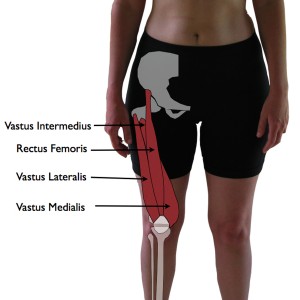 Dr. Travell called this muscle the “two-joint puzzler” because of its ability to cause trouble at both the hip joint and the knee joint. The trigger point in the rectus femoris causes a deep aching pain in the front of the knee, even though the trigger point itself is located up near the hip joint.
Dr. Travell called this muscle the “two-joint puzzler” because of its ability to cause trouble at both the hip joint and the knee joint. The trigger point in the rectus femoris causes a deep aching pain in the front of the knee, even though the trigger point itself is located up near the hip joint.
This trigger point may also cause a condition known as “buckling hip” in addition to knee pain. Though somewhat rare, this condition causes great fear in the people afflicted with it because they never know when their body might collapse suddenly while they are walking.
The Rectus Femoris Muscle
Location: The quadriceps femoris muscle group form the thigh musculature found on the front of the upper leg. The group is comprised of four muscles:
- The Vastus Lateralis muscle is found along the outside of the thigh.
- The Rectus Femoris muscle is found along the centerline of the thigh.
- The Vastus Medialis muscle is found along the inside of the thigh.
- The Vastus Intermedius muscle is found deep to the rectus femoris muscle along the centerline of the thigh.
Function: In everyday life, the quadricep muscle group as a whole functions to allow a person to squat, bend backwards, walk up or down stairs, and move from a standing to a seated position (or vice-versa). These muscles are not active while standing with the knees locked, but become active during the heel-strike and toe-off phases of walking and running.
Muscle Structure and Actions: Unlike the other quadriceps muscle that only cross the knee joint, the rectus femoris muscle crosses both the hip and knee joints. This muscle originates at the anterior inferior iliac spine (A.I.I.S) of the pelvis and travels down the midline of the thigh to attach to centrally on the patella bone of the knee. Contraction of this muscle produces hip flexion and/or knee extension.
Synergistic Muscles: All of the quadricep muscles act together to produce knee extension. The rectus femoris is assisted by the ilio-psoas and tensor fascia latae muscles in producing flexion at the hip joint. Trigger point activity can easily spread between all four of the quadriceps muscles, and between the rectus femoris and the ilio-psoas muscles, specifically.
Antagonistic Muscles: The primary muscles that oppose the knee extension produced the quadriceps are the hamstring and gastrocnemius muscles. The hip flexion produced by the rectus femoris is opposed by gluteus maximus, hamstrings, and adductor magnus muscles. Trigger points can occur concurrently between strong antagonist muscle groups like the quadriceps and hamstrings.
The Rectus Femoris Trigger Point and Referred Pain
The trigger point the rectus femoris muscle is found in the upper part of the muscle belly that lies just underneath its insertion into the anterior inferior iliac spine of the pelvic bone.
This trigger point projects a severe deep aching pain to the knee and deep into the knee joint itself, despite its location near the hip joint. This pain may also extend up into the lower thigh, and is usually worse at night when a person is trying to sleep. This trigger point may also produce a phenomenon known as hip buckling, where a person’s hip suddenly becomes weak and their body collapses at the hip joint.
What Causes Rectus Femoris Trigger Points?
The following events or activities may activate or reactivate the rectus femoris trigger point:
- The quadriceps muscle group as a whole are typically overloaded by “catching oneself” after stumbling or unexpectedly stepping into a hole. In these situations the muscles undergo a strong eccentric (lengthening) contraction as they try to decelerate the body’s full weight during the fall.
- A new exercise program that includes squats or deep knee bends may also overload these muscles.
- Unaddressed trigger point activity in the hamstrings can cause chronic tightness in these muscles. As the biomechanical counterpart to the hamstrings, the quadriceps will frequently develop trigger point activity in response to the chronic muscle tension in the hamstrings.
- Clients that have tension in their soleus muscle will often compensate for this when trying to squat down and lift something by overloading their quadricep muscles. The tight soleus prevents them from flexing their ankle (dorsiflexing) properly while squatting down.
- Skiing, and skiing accidents, are particularly hard on the quadricep muscles.
- Because this is the only quadricep muscle to act at the hip joint, the rectus femoris trigger point can be activated from abnormal hip mechanics, hip surgery, and hip joint disease.
- During daily activity, this muscle is rarely stretched sufficiently, so it’s trigger point activity can linger from the muscle always being kept in a shortened state.
- Holding something heavy on your lap while sitting (like a child) can aggravate the trigger point in this muscle.
Rectus Femoris Symptoms & Disorders
Clients with active trigger points in this quadriceps muscle will present with any of the following symptoms or clinical findings:
- Clients will complain of a deep aching pain in the front of the knee, and slightly above it in the lower thigh region, that often wakes them up at night.
- They may also experience a buckling hip condition, and weakness in the knee, when going down stairs.
- The client will often compensate for the buckling hip condition by walking on their tip-toe with the affected leg.
Related Disorders
- Knee Pain with Hip Disorders: Many people that undergo treatment or surgery for a hip pain disorder or pathology will often develop pain in the knee on their affected side as well. This knee pain is usually the result of trigger point activity in their quadricep and/or hamstring muscles but the patients are mistakenly told that it has it origin in the hip joint.
- Knee Joint Injury: Strains or tears of the ligaments and menisci are quite common in professional and recreational sports. As with any joint, the knee joint structures are susceptible to abnormal stress from chronic tension in the muscles that move the joint (i.e. the quadricep, hamstring, and gastrocnemius muscles). It is my opinion that many of these injuries could be avoided with some regular (maintenance) trigger point treatment to the vastus lateralis, vastus medialis, and hamstring muscles. I think this is especially true for the athletes at both ends of the conditioning spectrum (the poorly conditioned and highly conditioned athletes). Of course, many of these injuries occur from physical trauma to the leg and knee, and are thus unavoidable in the traditional sense.
- Phantom Limb Pain: Because the pain from trigger points is typically experienced in a another region of the body, it is often responsible for phantom limb pain in people that have had a limb amputated. These people may be told that their pain is “not real” and is fabricated in their mind, but in reality their pain is as real as anyone else’s pain and has its origin in trigger points in the remaining part of the limb or trunk. Referred pain doesn’t require the body part targeted by the pain to actually exist, as it’s just a neurological reflex designed to tell the brain to modify one’s physical activity so the muscle harboring the trigger point can rest and recover.
- Growing Pains: Unexplained knee and thigh pain in children is often attributed to “growing pains” when trigger point activity in the quadriceps (and other muscles) is the real cause. Children are constantly pushing their bodies to new limits and can easily overload the leg muscles while playing.
Treatment of Quadriceps Trigger Points
Effective treatment for knee pain complaints requires the therapist to locate and release the trigger points in the vastus lateralis, rectus femoris, and vastus medialis muscles together, which is why we have included all three muscles in the Trigger Point Therapy for Quadriceps Video + 23-page PDF Booklet.
Click on the image below to watch an excerpt from the Quadricep Trigger Points video on YouTube.
Related Articles:
- Vastus Lateralis Trigger Points: The Knee Pain Trigger Points – Part 1
- Vastus Medialis Trigger Points: The Knee Pain Trigger Points – Part 3
- The Hamstring Trigger Points: Hiding in Plain Sight
Related Instructional Videos:
